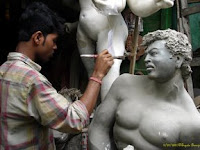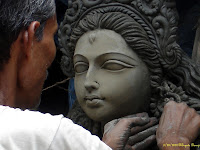 That’s the name of the place in Bengali. Loosely, that can be translated as “Potters’ Alley”. In spite of what the name might suggest, the people living there are not heroes of wizarding tales. However, they are not mere muggles either.
That’s the name of the place in Bengali. Loosely, that can be translated as “Potters’ Alley”. In spite of what the name might suggest, the people living there are not heroes of wizarding tales. However, they are not mere muggles either.They are wizards of a different kind. They are humans who shape gods.
Unless one visits this tiny lane in Northern Kolkata between Shovabazaar and Baghbazaar close to the river, one can never imagine that such a place could exist in the world. Or as the great Shibram Chakraborty would have put it, “You could have still believed it if you didn’t see it with your own eyes, but once you see it, it’s impossible to believe.” This unbelievability stems from the fact that the place seems to be extremely small for any decent work, and yet, hundreds of clay idols are made there throughout the year. Kumortuli is the nerve centre of the idol making industry in Kolkata.

A typical studio in Kumortuli is, say, ten feet wide and twenty long (though some are longer) and ten feet high. Within each of these tiny studios you will find anywhere between five to ten full size Durga idols, not to mention the other gods and goddesses. They have to be kept so close to each other that their hands touch. They are so high that their heads are close to the ceiling and the artist has to climb on a stool or a small ladder to work on the face. The interiors are so cramped and dimly lit that a person like me would find it difficult to do anything there, let alone artistic work. Yet, these people are creating hundreds of clay idols inside these very rooms, many of which are larger than life and breathtakingly beautiful. And yes, most these 'rooms' are nothing but temporary shelters made of bamboo poles and polythene sheets.

They can't look at their idols from a distance, and yet the idols are perfectly proportioned. They paint under dim bulbs, and yet it is impossible to find one flawed line in an idol. The details are amazing: the jewelry and garlands of Durga (wherever these are made of clay), the muscles of Mahishasura, the teeth of the lion, the markings on the snake. In some of the larger studios, they have even created a loft kind of place that serves as a second floor to keep even more idols.

Kumortuli is also the home to other Puja related artisans. The idols have to be painted, dressed, and hair has to be attached. Ornaments and pandel decorations made of paper and pith and metal foil, or these days, of thermacole and plastic and fibreglass are also made here in Kumortuli. As I watched a man create a crown by patiently attaching small pieces of shiny plastic one by one on a stiff paper base, I wondered how much time it takes to create a single crown. And then there are thousands of them to be made. Clearly, the work goes on throughout the year.
"Did you make all of them inside, or did you put them in after making them outside?" I asked a man who was relaxing outside his studio which was packed with lovely idols. "Inside, of course! How can we make them outside?" he replied gruffly. I hastened to make amends, by saying that I can't understand how they could make such beautiful idols within such a confined space. "That's what our job is," was his smug reply. I can't blame him for getting irritated at some ignorant fool with a camera who asks him silly questions, especially when he is relaxing. All of them have to work very hard and yet find it difficult to make both ends meet. Most of them are quite accustomed to photographers and a few even enthusiastically encouraged me to take photos. One person also asked me if I was looking for an idol to buy.

When I went there (September end) most of the idols had already taken shape and were either being given the final touches, or being painted. However, there were some in various stages of completion, ranging from just straw figures to unpainted headless bodies. The idols are made like this: first a frame is made with bamboo. Then the figures are given shape with straw. A layer of clay mixed with little straw pieces is then used to cover the straw. After this dries up, progressively smoother layers are added and cracks are filled up. The heads are made in dies, and then touched up after being attached to the bodies. Then comes painting. These days, many artists use spray paint for the base colours. Brush is used for the details. Then hair, mane, fur etc made from jute strands are added, and the gods and goddesses are dressed up with clothes and the ornaments. In some cases (like the one in the photo above left) the hair, clothes and ornaments are also made of clay. In this video below you can see a man making clay fingers using a technique that seems incredibly simple. I'm sure I couldn't make such realistic fingers even if I tried for years. (I know YouTube videos are blocked in many offices. This is for the people who can see it).
My time was short. I had to leave for Hooghly soon, so after spending about an hour and a half in Kumortuli, I left for the Shovabazaar ferry ghat with my sister. However, spending this time among these people was a humbling experience for a person who earns his salary by Ctrl+C-ing and Ctrl+V-ing the Internet. I felt myself echoing what my sister said: "We spent whole of our lives studying useless stuff, but learnt nothing worthwhile, like making figures out of clay."
[Update: You can view the photos that I took here. I am also including a link to an album by my friend Souvik who went to Kumortuli about a week after me and captured the idols at a more advanced state of completion.]
Very very nice article.
ReplyDeleteCongrats Sugata! Your well-written article certainly deserves the appreciation by Pundits:-)
ReplyDeleteI have always wanted to visit Kumartuli at Dussehra time!
ReplyDeleteThese are powerful portrayals of the Hindu devi.
I'd like to invite you to join our Flickr group,
50 Million Missing
at
www.flickr.com/groups/50_million_missing
and add your photos of the Devi statues and their creators.
We are an international campaign (based in Calcutta) dedicated to raising awareness of Indian women's issues.
Thanks!
Wow Sugata!I am Painfully impressed by the account of your visit to kumartuli....I dont know if I will ever get a chance to visit it in person but visiting it through your eyes is a wholesome experience... Seeing Ma's face..the peace we experience DOES require some strange divine power,I have always thought.I guess the dim atmosphere fosters the power in the face of the deity and power in the muscle of the asuras....Salute to our culture,tribute to Art!
ReplyDeleteLovely, lovely post. The next time I am in Kolkatta (and if you happen to be around) will you please, please show me around? All I ever get to do when in Kolkatta is shopping.
ReplyDeleteDude,
ReplyDeleteYou made me miss home. Its Durga Pujo, and I'm unable to visit family.
@shreemoyee: Thank you! :)
ReplyDelete@abhijit: Thanks a lot!
@sirensongs: indologist at large : Joined. Thanks for inviting me.
@monami: I also believe that these people have some God gifted skill... one can't do this just by practice.
@anyesha: Thanks! Sure, I'd love to do that, though to see Kumortuli in its full glory you must come close to Durga Puja.
@kalyan: It was like that for me for the past two years. Thanks for visiting.
Sugata, that was a really informative post and I am sure I would have enjoyed it as much in live as through the words you put. I wanted to visit Kolkata this time of the year, but things didn't work out. May be the next time I'll be luckier....
ReplyDelete